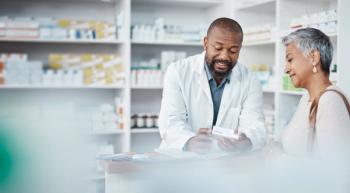Community pharmacy-based continuous glucose monitoring (CGM) programs led by pharmacists have the potential to reduce hemoglobin A1c (HbA1c) among patients, boost revenue for clinics, and increase patient willingness to participate in future care, according to research published in the Journal of the American Pharmacists Association.1
Although pharmacist-led CGM initiatives have been previously demonstrated to help patients reduce HbA1c levels and achieve daily glycemic goals, little evidence has delved into this effect in a community pharmacy setting. To fill this knowledge gap, investigators sought to evaluate the impact of a CGM service led by postgraduate year 1 community-based pharmacy residents on HbA1c, revenue, and patient satisfaction in a family medicine clinic.
Key Takeaways
- Despite the prevalence of diabetes in the US, diabetes technology uptake is low. Community pharmacists' frequent contact with patients allows them to address concerns and promote wider CGM use.
- By implementing pharmacist-led CGM services in community pharmacies, patients might experience better health outcomes, and clinics could see increased revenue through billing for pharmacist services.
- Establishing CGM services in a community setting may also increase patients' willingness to continue receiving care at the pharmacy.
Eighteen patients who were 18 years or older, had HbA1c higher than 7%, and had Medicare, Medicaid, or commercial insurance coverage for CGM participated in the study. Participants received pharmacist-driven appointments for CGM application, data interpretation, diabetes education, and lifestyle management for 3 months. In initial appointments, pharmacy residents provided patients with 2 sensors; they used the first to demonstrate the application process, and after ensuring the patients had the knowledge and comfort levels to do so on their own, sent patients home with the second sensor to apply themselves. Pharmacy residents also helped patients navigate and pair the mobile phone application required to interpret sensor data.
Diabetes education and lifestyle management counseling included discussions on diet, exercise, medication adherence, insurance coverage, and glycemic goals.
HBA1c values were measured at enrollment and conclusion of the study, and patients recorded their responses to a satisfaction survey at program conclusion. To assess revenue, investigators collected the Current Procedural Terminology (CPT) codes 99211, 95259, or 95251 billed at each appointment from the clinic’s electronic health record.
READ MORE: Addressing The Need for Better Access to CGM in Low-Income Areas
Across participants, investigators gleaned a 1.2% mean reduction in HbA1c (n=12; 9.7% to 8.5%). In total, 40 CPT codes were billed that generated $3671.40 in revenue. Although only half the participants filled out satisfaction surveys, most reported being satisfied with the CGM service and its individual components, as well as that they would be willing to continue to use CGM devices and receive diabetes education from a pharmacist in the future (n=8, 89%).
“While the study was not powered to detect statistical significance, the descriptive analysis does represent a reduction in HbA1c and participation in the CGM service pilot program,” wrote investigators.1 “In addition to wearing a CGM device, many educational interventions unrelated to CGM also occurred with each patient, including counseling on diet, exercise, adherence, insurance coverage, and glycemic goals. This confounds our ability to say HbA1c reduction occurred as a direct impact of wearing a CGM device. However, this can also be seen as a benefit of the program being led by a pharmacy resident who is able to provide those educational interventions in combination with CGM device counseling.”
Although over 38 million people in the US have diabetes and diabetes technology has been well established by organizations like the American Diabetes Association to improve the lives and health of those with the condition,1 uptake of CGM usage among patients with diabetes is low. Barriers to uptake vary widely. For some, the cost of the device or supplies, or issues with insurance coverage, keep patients from using the self-monitoring devices. For others, barriers are more attitudinal: people may be nervous that the device does not work, nervous to rely on technology, or confused about how to use the device.2
Community pharmacists are uniquely positioned to address barriers to CGM use due to their frequent interactions with patients. By offering education on the CGM at the point of dispensing, which coincides with CGM device pick-ups as often as every 28 days for some patients, pharmacists can provide ongoing support and address any concerns that patients may have. This sustained education has the potential to improve CGM uptake among patients with diabetes. What’s more, community-based pharmacists can collaborate with primary care providers to integrate CGM into treatment plans, fostering a network of collaborative care.
“This study provides additional evidence that pharmacy services can have positive patient satisfaction and health outcomes, while generating revenue for the community pharmacy through the use of pharmacy residents,” concluded investigators.1 “This study also [provides] additional evidence showing how clinical service agreements for pharmacy services can improve health outcomes and patient satisfaction while reducing workload on the primary care provider.”
READ MORE: Continuous Glucose Monitoring Resource Center
References
1. Miller L, Woodyear J, Marciniak MW, Rhodes LA. Evaluation of a community-based pharmacy resident-led continuous glucose monitoring program within a family medicine clinic. J Am Pharm Assoc (2003). Published online March 29, 2024. doi:10.1016/j.japh.2024.102078
2. Lanning MS, Tanenbaum ML, Wong JJ, Hood KK. Barriers to continuous glucose monitoring in people with type 1 diabetes: Clinician perspectives. Diabetes Spectr. 2020;33(4):324-330. doi:10.2337/ds19-0039







































































































































